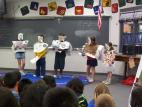|
|
|
|
|
HOMEIntroduction to Using Reader's Theater in the ClassroomLewis & ClarkTraveling WestwardGold RushNative AmericansPioneer LifeTranscontinental Railroad |
Introduction to Using Reader's Theater in The Classroom  What is Reader's Theater? Reader's Theater for Kids! Reader's Theater and Historical Fiction Gold Rush Reader's Theater: Reader's Theater Script for The Ballad of Lucy Whipple Native Americans Reader's Theater: Reader's Theater Script for Night of the Full Moon What is Reader's Theater?Reader's Theater is a presentation by two or more individuals who read directly from scripts which have been adapted from a book or other literary work. Techniques for Reader's Theater vary but generally performers focus on dramatic interpretations by using their voice, hands and facial expressions rather than by moving across a stage. Performers can sit or stand still while they read the scripts allowing them to focus on reading fluency and effective communication. Occasionally an entrance or exit of a performer from a stage will clarify what is happening in the story. Because the audience participates imaginatively, props and scenery aren't necessary. Nevertheless, selective use of limited props (a hat, a book, a newspaper etc.) might help performers interpret their characters. Back to TopReader's Theater for Kids!Reader's Theater can be a fabulous way to introduce literature to kids. It can be used to inspire excitement about books, encourage reading fluency, promote cooperative learning and teach effective communication skills. In a classroom, it can be used to preview a book or unit as well as review important aspects of a book. Children can also adapt their own Readers Theater scripts as a way to present book reports. In any setting it can be used to arouse enthusiasm and motivate children to read. Different sections of a book can be brought together in a Readers Theater script. Scripts can be used as a way to introduce books to children or as spring boards for discussion about important themes in a story. Minimal dialogue can be added to a script in order to help a story flow from one section to the next. Clearly, different sections of a book can be used to create scripts and different themes could be emphasized. Creating a script which meets the needs of a particular group of children can be an important part of the Readers Theater experience. Allowing children to create their own scripts can also be a wonderful learning experience for them. Back to TopReader's Theater and Historical FictionThis website was created to promote children's historical fiction. The creators of this website believe that historical fiction brings history to life. Kids can better understand history and feel more engaged when they read about children who lived in another era but still shared many of their same feelings and experiences. Instead of memorizing dates and theories, kids can empathize with people who are in many ways just like themselves. Encouraging the use of historical fiction which has been adapted to Readers Theater is another way to spark interest in this genre and bring history to life. Back to TopThis web site was produced by:Anne Miller, Karen Andring, and Aurora Grey
|